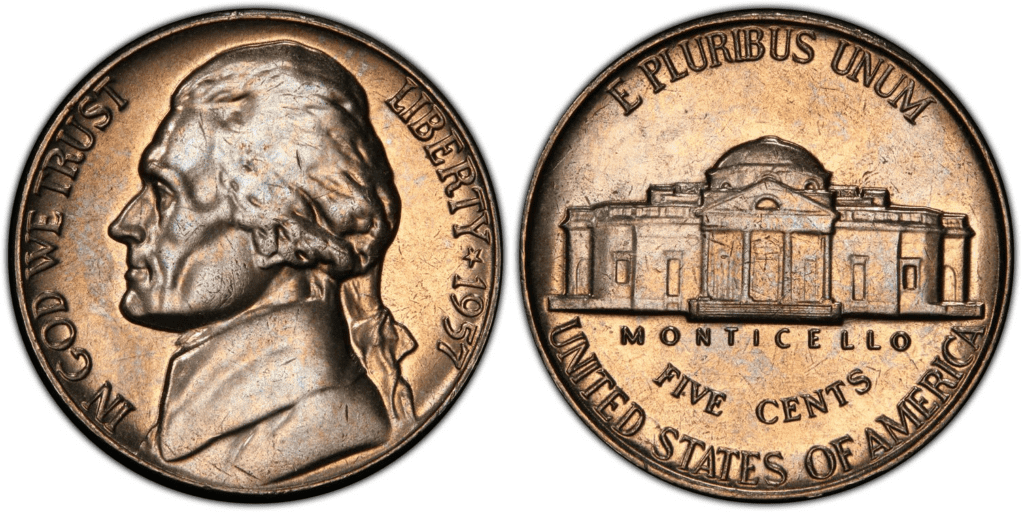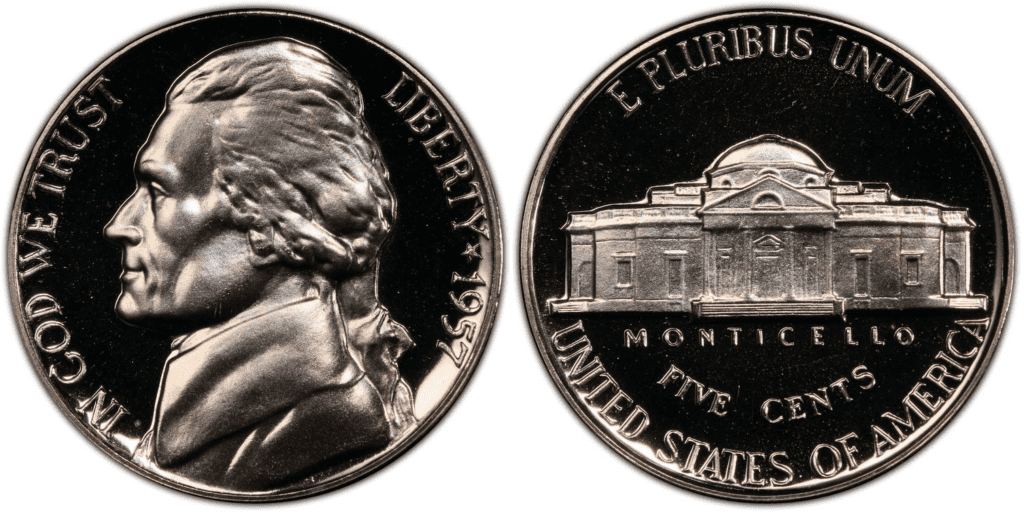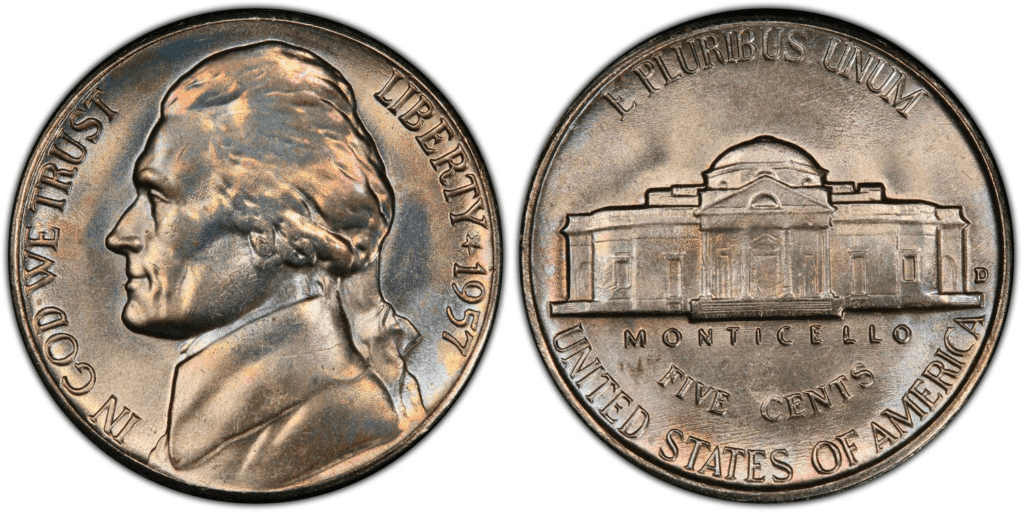What Is the 1957 Jefferson Nickel Made Of?
Are you looking for some details about the 1957 Jefferson nickel? If yes, then you’re in the right place. In this post, you’ll learn more about the composition, design, price, and other essential details of the nickel issued in 1957.
The 1957 Jefferson nickel is made of 75% Copper and 25% Nickel. It also has the following specifications:
- Edge – plain
- Weight – 5.00 grams
- Diameter 21.20 millimeters
During the war, nickels were referred to as the Wartime Nickels, where they were made of 56% copper, 35% silver, and 9% manganese.
The nickel first got its Jefferson image in 1938, and he has remained the face of the nickel. The Jefferson nickel replaced the Buffalo nickel, which was difficult to mint.
Felix Schlag made the original design from 1938 until 2005 when it was replaced by Joe Fitzgerald’s design. However, in 2006, it was again replaced by Jamie Franki’s design of Jefferson facing forward. The coin’s reverse remained the same from 1938 except for 2004 and 2005, when the reverse featured commemorative designs.

The obverse features the left profile of Thomas Jefferson, the 3rd president of the United States and one of the Founding Fathers. The inscriptions on the obverse include the US motto, “IN GOD WE TRUST,” “LIBERTY,” and “1957.”
On the reverse, you’ll find the mansion of Jefferson, the Monticello. Inscriptions include the following:
- E PLURIBUS UNUM
- MONTICELLO
- FIVE CENTS
- UNITED STATES OF AMERICA
- Mint mark (if present)
1957 Jefferson Nickel Varieties
The 1957 Jefferson Nickel comes with three main varieties: 1957 P Jefferson nickel, 1957 P Jefferson proof nickel, and 1957 D Jefferson nickel.
Aside from the standard varieties of the 1957 Jefferson nickels, some have errors, giving rise to a different type of coin.
Here are the 1957 Jefferson nickel varieties that you should know:
1957 P Jefferson nickel
Edge: Smooth
Mint Mark: No mint mark
Place of minting: Philadelphia
Year of minting: 1957
Face Value: $0.05 (fifty cents)
Price: $0.05 to $40 (or more)
Quantity produced: 38,400,000
Designer: Felix Schlag
Composition: 75% copper and 25% nickel
Mass: 5 grams
Diameter: 21.21 mm
Thickness: 1.95 mm

photo source: PCGS
The 1958-P Jefferson nickel was struck in the Philadelphia Mint, and there were more than 38 million coins. Unfortunately, there’s no mint mark, and the average price ranges from $0.05 to $40.
1957 P Jefferson nickel (proof)
Edge: Smooth
Mint Mark: No mint mark
Place of minting: Philadelphia
Year of minting: 1957
Face Value: $0.05 (fifty cents)
Price: $0.05 to $40.00 (or more)
Quantity produced: 1,247,952
Designer: Felix Schlag
Composition: 75% copper and 25% nickel
Mass: 5 grams
Diameter: 21.21 mm
Thickness: 1.95 mm

photo source: PCGS
The 1957-P proof Jefferson nickel was also struck in the Philadelphia Mint. At the end of 1957, there were more than 1.2 million P-proof nickel coins. There’s no mint mark, and the price can start from $0.05 to $40.00. The Philadelphia Mint produced proof coins and sold them to collectors from 1938 to 1942.
If you’re looking for 1957 P-proof Jefferson nickels, you’re in for a treat because these coins should be easy to find up to about PR 67 grades. Unfortunately, however, the number of P-proof nickels in PR68 has become scarce, and they are tough to find. PR69-proof nickels are even rarer; only a few examples exist today.
1957 D Jefferson nickel
Edge: Smooth
Mint Mark: D
Place of minting: Denver
Year of minting: 1957
Face Value: $0.05 (fifty cents)
Price: $8 to $20.00 (or more)
Quantity produced: 136,828,900
Designer: Felix Schlag
Composition: 75% copper and 25% nickel
Mass: 5 grams
Diameter: 21.21 mm
Thickness: 1.95 mm

photo source: PCGS
The Denver Mint produced the highest number of mintages for the 1957 Jefferson nickel. The Mint produced more than 136 million of these coins. This should be expected since the Denver Mint is focused on producing many coins for circulation. On the other hand, the Philadelphia Mint produced both standard and proof coins.
You’ll find the “D” mint mark between the right side of the Monticello and the edge of the coin. The average price ranges from $0.05 to $20.00.
List Of 1957 Jefferson Nickel Errors
The 1957 Jefferson nickel is no exemption when it comes to coin errors. With more than 176 million nickel coins produced in 1957, it is just a matter of time before a mistake error can occur.
The 1957 nickel errors may include planchet, die, and mint striking errors.
For the planchet errors, some 1957 Jefferson nickels had clipped or folded planchets. Some also have the wrong mixture; thus, when the planchet cools down, there are discolorations, cracking, or peeling on the coin’s surface.
Die errors may also happen at any time. As you can imagine, the US Mint produced thousands of 1957 nickels daily. The minting machine worked fast and struck as many planchets as possible. Because of the repeated hitting action of the machine, the die may break.
When a die breaks, a crack appears on the die. When the die hits the planchet, this crack will also be engraved on the coin. Die-break errors would manifest themselves as fine lines on the coin.
There were also instances when the die hit the planchet twice. This is called the doubled die reverse or doubled die obverse error. When this happens, the engraved elements become doubled. Doubled-die errors are among the most sought-after errors of many coin collectors.
How Much Is The 1957 Jefferson Nickel Worth Today?
As its face value suggests, the 1957 Jefferson nickel is worth 5 cents. But, unfortunately, the melt value isn’t that big, which is about $0.0709.
Nevertheless, you can be sure that 1957 Jefferson nickels are worth more than their face value or melt value.
To give you an idea, here’s a 1957 Jefferson Nickel values chart:
| Coin | Condition | Grade | Mintage | Value |
| 1957 P Jefferson Nickel | Circulated/mint | Not graded | 38,400,000 | $0.05 to $40 |
| 1957 P Jefferson Nickel | Uncirculated/mint | MS-65 | 38,400,000 | $46 to $94 |
| 1957 P Jefferson Nickel | Uncirculated/mint | MS-66 | 38,400,000 | $134 to $1,320 |
| 1957 P Jefferson Nickel | Uncirculated/mint | MS-67 | 38,400,000 | $630 to $3,360 |
| 1957 P Jefferson Nickel (Proof) | Uncirculated/proof | Not graded | 1,247,952 | $0.05 to $40.00 |
| 1957 P Jefferson Nickel (Proof) | Uncirculated/proof | MS-67 | 1,247,952 | $6 to $40 |
| 1957 P Jefferson Nickel (Proof) | Uncirculated/proof | MS-68 | 1,247,952 | $15 to $40 |
| 1957 P Jefferson Nickel (Proof) | Uncirculated/proof | MS-69 | 1,247,952 | $73 to $423 |
| 1957 D Jefferson Nickel | Circulated/mint | Not graded | 136,828,900 | $8 to $20.00 |
| 1957 D Jefferson Nickel | Uncirculated/mint | MS-65 | 136,828,900 | $5 to $30 |
| 1957 D Jefferson Nickel | Uncirculated/mint | MS-66 | 136,828,900 | $7 to $50 |
| 1957 D Jefferson Nickel | Uncirculated/mint | MS-67 | 136,828,900 | $50 to $180 |
As you can see, some 1957 nickels are just too valuable. Now, to help you better understand how much a 1957 nickel can be, you need to check out the auction records for these coins.
For example, the auction record for the 1957 cent is $7,475. This was a proof coin with a grade of PR68. It was sold in January 2010 by Heritage Auctions.
For the 1957 P, regular strike, the auction record is $4,313. It was a coin with an MS66 grade and a Full Step rating. Finally, the 1957-D nickel has an auction record of $4,460.
How Does The Grading System Work?
The Sheldon Scale is used by numismatists to provide a numerical value to coins. The Sheldon Scale goes from poor (P-1) to perfect mint state (P-1) (MS-70). Coins were originally evaluated using words to reflect their condition (Good, Fair, Excellent, Etc.). Unfortunately, coin collectors and dealers had different ideas about what each of these terms represent.
Professional numismatists joined together in the 1970s and established CoinGrading standards. These numismatists now assign grades at key places on the seventy-point scale, using the most regularly utilized numeric points in conjunction with the original adjective grade. The following are the most common coin grades:
-
-
- (P-1) Poor – Indistinguishable and probably damaged; if used, must have a date and mintmark; otherwise, rather battered.
- (FR-2) Fair – Nearly smooth, but without the damage that a coin graded Poor often possesses. The coin must have enough detail to be identified.
- (G-4) Fair – Inscriptions have merged into the rims in some areas, and important elements have been mostly erased.
- (VG-8) Very Good- A little weathered, but all of the primary design elements are visible, albeit faintly. There is little if any, central detail left.
- (F-12) Good – The item is very worn, yet the wear is even, and the overall design details stand out clearly. Rims are almost completely isolated from the field.
- (VF-20) Very Fine – Moderately weathered, with some finer features still visible. The motto or all letters of LIBERTY are readable. Both sides of the coin have entire rims that are separated from the field.
- (EF-40) Extremely Fine – Gently used; all gadgets are visible, and the most important ones are bold. The finer details are bold and clear, however, light wear may be seen.
- (AU-50) Uncirculated – Slight evidence of wear on the coin’s design’s high points; may have contact marks; eye appeal should be adequate.
- (AU-58) Uncirculated Choice – Slight traces of wear, no severe contact marks, almost full mint shine, and great eye appeal.
- (MS-60) Mint State Basal – Strictly uncirculated; no indication of wear on the coin’s highest points, but an unsightly coin with reduced luster, visible contact marks, hairlines, and other flaws.
- (MS-63) Mint State Acceptable – Uncirculated, but with contact scratches and nicks, little reduced shine, but otherwise appealing appearance. The strike is weak to average.
- (MS-65) Mint State Choice – Uncirculated with great mint shine, very little contact blemishes, and exceptional eye appeal. The strike is unusually severe.
- (MS-68) Mint State Premium Quality – Uncirculated with superb luster, no obvious contact marks to the naked eye, and exceptional eye appeal. The strike is quick and appealing.
- (MS-69) Almost Perfect Mint State – Uncirculated with perfect brilliance, a sharp and appealing strike, and extremely good eye appeal. A near-perfect coin with minor imperfections in the planchet, strike, and contact markings (seen only under 8x magnification).
- (MS-70) Mint State Perfect – Under 8x magnification, there are no tiny imperfections discernible; the strike is crisp, and the coin is perfectly centered on a beautiful planchet. Rarely seen on a coin, this coin is bright and whole, with original luster and exceptional eye appeal.
-
Where To Buy Or Sell 1957 Jefferson Nickel?
The easiest and quickest way to buy or sell 1957 Jefferson nickel today would be through the Internet. In a digital world, you can find your needed coin with just a few pushes of a button.
The most common places to start would be Amazon and eBay. These platforms allow you to both sell and buy coins. All you need to do is create your account and be ready to go.
You can also do a Google search and find specialized websites that sell and buy coins. These websites can include Coin Appraiser, USA Coin Book, JM Bullion, and Grey Sheet.
Aside from the Internet, you can also visit physical stores or establishments. For example, auction houses are known to sell rare and beautiful coins. If your timing is right, you might be able to buy a 1957 quarter.
Other stores would include coin shops, antique stores, and pawnshops. You may also try to join clubs and groups of collectors. They might be able to help you buy or sell 1957 Jefferson nickels.
FAQs
How much is an uncirculated nickel worth?
The uncirculated nickel can be worth around $0.05 to $5. But, of course, it can be more if your nickel is rare or is in good condition.
Is the 1957 nickel error worth anything?
Yes, the 1957 nickel error is worth a lot of money. For example, a doubled-die error nickel can be sold for hundreds of dollars.
Is there silver content in the 1957 nickel?
The 1957 nickel doesn’t have silver in it. Instead, this coin is made of 75% copper and 25% nickel.



